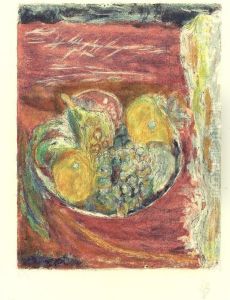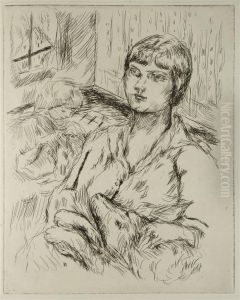Jacques Charles Bonnard Paintings
Jacques Charles Bonnard, not to be confused with the more widely known French painter Pierre Bonnard, was a French artist born in 1905. His artistic career, while less documented in the broad annals of art history, contributed to the cultural and artistic movements of the 20th century in France. Jacques Charles Bonnard's work, spanning several decades, encapsulates a period of significant transformation in European art, reflecting the shifts from traditional to modernist expressions.
Bonnard’s early life and education in the arts were marked by the post-World War I era, a time when Europe was redefining itself culturally and politically. He was part of a generation that sought to break away from the rigid constraints of 19th-century academic art, leaning instead towards the burgeoning movements of modernism and abstraction that were beginning to take shape. Though details of his specific training are sparse, it is known that like many artists of his time, he would have been exposed to a mix of classical training and the avant-garde influences permeating Paris and other cultural hubs in Europe.
Throughout his career, Jacques Charles Bonnard moved through various styles and mediums, exploring and sometimes intertwining the realms of painting, drawing, and printmaking. His work, though not as prominently recognized or as extensively documented as some of his contemporaries, still reflects the complex interplay of light, color, and form that characterized the evolving artistic landscape of the 20th century. Bonnard was adept at capturing the essence of his subjects, often focusing on landscapes, still lifes, and occasionally portraiture, imbuing them with a sense of vitality and emotion that transcended the apparent simplicity of the scenes depicted.
Despite the shadow cast by the more famous Pierre Bonnard, Jacques Charles Bonnard carved out his own niche within the French art scene. His contributions, though perhaps more subtle and less celebrated, are part of the broader narrative of French modernism and its departure from traditional representation to a more exploratory and expressive approach to art. His death in 1973 marked the end of an era that spanned some of the most tumultuous and transformative periods in European history, from the aftermath of World War I through the upheavals of World War II and into the post-war period, which saw a reevaluation and reinvigoration of artistic practices.
In retrospect, Jacques Charles Bonnard’s legacy is that of an artist who navigated the complexities of his time with a personal vision that, while it may not have garnered widespread acclaim, contributed to the rich tapestry of 20th-century French art. His works, though less known, offer insights into the shifts in style, technique, and thematic exploration that defined a century of unprecedented change in the art world.

